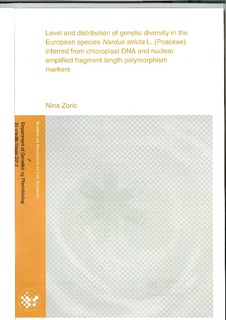Level and distribution of genetic diversity in the European species Nardus stricta L. (Poaceae) inferred from chloroplast DNA and nuclear amplified fragment length polymorphism markers
Master thesis
Permanent lenke
http://hdl.handle.net/11250/189603Utgivelsesdato
2013-10-21Metadata
Vis full innførselSamlinger
- Master's theses (IPM) [204]
Sammendrag
The present level and distribution of genetic variation is defined by the
interplay between gene flow, drift, inbreeding, mutations and selection and reflects
both contemporary and historical processes (e.g. Pleistocene glaciations). Especially,
the breeding strategy of a species is a dominant factor influencing the pattern of
genetic diversity. In this study, using AFLP molecular markers and cpDNA
sequences, I investigate neutral genetic variation of nuclear and chloroplast
genomes of European populations of the grass Nardus stricta.
The results of the present study indicate a lack of genetic variation in
European N. stricta populations; there were no cpDNA variation detected and only
the Austrian population had different AFLP pattern from other populations
analyzed. In earlier studies, it has been suggested that N. stricta reproduces via
agamospermy, and the observed lack of genetic variation strengthens this
hypothesis about asexual reproduction in N. stricta. Also, given the lack of variation
in both nuclear and chloroplast DNA it is likely that the present European
populations of N. stricta come from one refugium only, but it is impossible to say
which based on our data. However, nucleotide variability is not the only source of
variation that results in phenotypic variation. Epigenetic variation might enable the
wide geographical distribution of N. stricta and explain the observed lack of
nucleotide variation. This might be interesting to investigate further.
Even though AFLP is a high resolution technique, the resolving power of the
techniques used should be carefully investigated. I strongly emphasize that these
results are preliminary as they are only based on screening of a few populations.
More populations need to be screened and possibly also more primer/restriction
enzymes combinations before any conclusions can be drawn.
